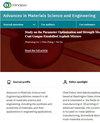A Practical Swelling Constitutive Model of Anhydrite and Its Application on Tunnel Engineering
4区 材料科学
Q2 Engineering
引用次数: 0
Abstract
Swelling of anhydrite rock causes serious damage to the tunnel and generates high additional costs in the process of tunnel construction and operation and has gradually become one of the main factors that threaten the safety of the tunnel. It is extremely difficult to predict swelling pressures and deformations accurately based on conventional swelling constitutive models. Thus, a new practical swelling constitutive model of anhydrite for tunnel engineering has been developed. First, swelling tests of natural anhydrite samples focusing on the time effect have been designed and conducted, whose test results show that swelling strain-time can be described by the S-curve model and that swelling stress-strain can be described by the quadratic model. Second, a swelling constitutive model with considering the time effect has been developed to reproduce the swelling behavior of anhydrite observed in swelling tests. This model can track the evolution of swelling activity in tunneling, which has practical significance for process simulation and process control of swelling disaster. Then, this model has been implemented within ANSYS for numerical simulation of the Lirang tunnel. Based on simulation results, useful measures have been proposed. Satisfactory results have been achieved according to the feedback from the site.无水石膏的实用膨胀构造模型及其在隧道工程中的应用
无水岩的膨胀会对隧道造成严重破坏,并在隧道建设和运营过程中产生高昂的额外成本,已逐渐成为威胁隧道安全的主要因素之一。根据传统的膨胀构造模型,要准确预测膨胀压力和变形是非常困难的。因此,我们开发了一种用于隧道工程的新型实用无水石膏膨胀构造模型。首先,设计并进行了以时间效应为重点的天然无水石膏样品膨胀试验,试验结果表明,膨胀应变-时间可以用 S 曲线模型描述,膨胀应力-应变可以用二次模型描述。其次,建立了考虑时间效应的膨胀构成模型,以再现膨胀试验中观察到的无水石膏的膨胀行为。该模型可跟踪隧道中膨胀活动的演变,对膨胀灾害的过程模拟和过程控制具有实际意义。随后,该模型在 ANSYS 中实现,用于里郎隧道的数值模拟。根据模拟结果,提出了一些有用的措施。根据现场反馈,取得了令人满意的结果。
本文章由计算机程序翻译,如有差异,请以英文原文为准。
求助全文
约1分钟内获得全文
求助全文
来源期刊

Advances in Materials Science and Engineering
Materials Science-General Materials Science
CiteScore
3.30
自引率
0.00%
发文量
0
审稿时长
4-8 weeks
期刊介绍:
Advances in Materials Science and Engineering is a broad scope journal that publishes articles in all areas of materials science and engineering including, but not limited to:
-Chemistry and fundamental properties of matter
-Material synthesis, fabrication, manufacture, and processing
-Magnetic, electrical, thermal, and optical properties of materials
-Strength, durability, and mechanical behaviour of materials
-Consideration of materials in structural design, modelling, and engineering
-Green and renewable materials, and consideration of materials’ life cycles
-Materials in specialist applications (such as medicine, energy, aerospace, and nanotechnology)
 求助内容:
求助内容: 应助结果提醒方式:
应助结果提醒方式:


